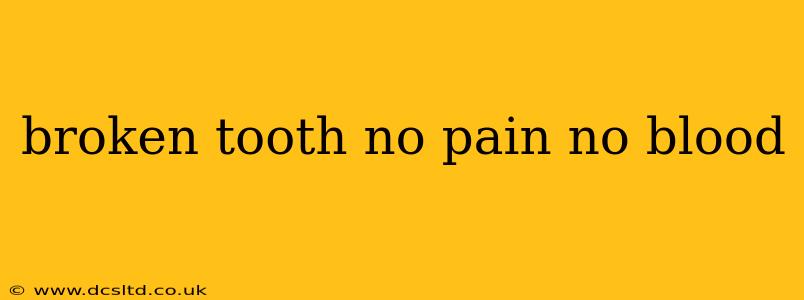A broken tooth without pain or bleeding might seem insignificant, but it's crucial to address it promptly. Ignoring the problem can lead to more severe issues down the line, such as infection, increased sensitivity, or even tooth loss. This comprehensive guide will help you understand what to do when faced with a painless, bloodless broken tooth.
What Causes a Painless, Bloodless Broken Tooth?
Several factors can contribute to a broken tooth showing no immediate signs of pain or bleeding. The location and extent of the fracture play a significant role. A small chip on the outer enamel might not expose the dentin or pulp, resulting in minimal or no discomfort. Similarly, a fracture on the back of a tooth, less prone to biting forces, might go unnoticed.
However, the absence of pain and bleeding doesn't mean there's no damage. The fracture might be more extensive than it appears, potentially involving the underlying dentin or even the tooth's pulp (the innermost part containing nerves and blood vessels). Over time, these unseen injuries can lead to complications.
What Should I Do if I Have a Broken Tooth with No Pain or Bleeding?
Even without pain or bleeding, it's vital to seek professional dental care. Here’s why and what steps you should take:
1. Schedule an Appointment with Your Dentist Immediately: This is the most critical step. Your dentist will conduct a thorough examination to assess the extent of the damage. X-rays are often necessary to identify hidden fractures.
2. Locate Any Broken Pieces: If possible, carefully collect any fragments of the tooth and bring them to your dentist. This can sometimes aid in the repair process. Wrap the fragments in a clean, damp paper towel or tissue to keep them moist.
3. Avoid Chewing on the Affected Tooth: Minimize pressure and force on the broken tooth to prevent further damage or potential complications. Chewing on the opposite side of your mouth might be necessary.
4. Rinse Your Mouth Gently: Rinse your mouth with warm salt water to help clean the area and reduce the risk of infection. Avoid aggressive rinsing or brushing near the fracture site.
5. Watch for Changes: Although you might not experience pain initially, monitor the tooth for any changes – increasing sensitivity to hot or cold, pain when chewing, or swelling in the gum area. Contact your dentist immediately if you notice any changes.
What are the Treatment Options for a Broken Tooth?
The treatment plan for a broken tooth depends on several factors: the location and extent of the fracture, the involvement of the dentin or pulp, and the overall condition of the tooth. Possible treatments include:
- Bonding: For minor chips, bonding involves applying a tooth-colored resin to repair the surface.
- Veneer: A thin shell of porcelain placed over the tooth's surface to improve aesthetics and protect the damaged area.
- Crown: A cap placed over the entire tooth to provide strength and protection.
- Root Canal: If the fracture reaches the pulp, a root canal may be necessary to remove the infected pulp and prevent further complications.
- Extraction: In severe cases, extraction might be the only option.
How Can I Prevent Broken Teeth?
Preventing broken teeth involves several measures:
- Wear a Mouthguard: This is especially important for athletes or individuals at risk of trauma to the mouth.
- Avoid Chewing on Hard Objects: Refrain from biting on ice, hard candy, or pens.
- Practice Good Oral Hygiene: Regular brushing and flossing help maintain the strength of your teeth.
What Happens if I Don't Treat a Broken Tooth?
Ignoring a broken tooth can lead to a range of problems, including:
- Increased Sensitivity: Exposure of the dentin can lead to sensitivity to hot, cold, or sweet foods and drinks.
- Infection: Bacteria can enter the tooth, causing pain, swelling, and potentially an abscess.
- Tooth Loss: Severe fractures might necessitate extraction to prevent further complications.
Remember: Early intervention is crucial. Don't hesitate to contact your dentist even if you're experiencing no pain or bleeding. A seemingly minor fracture can become a significant dental problem if left untreated.
